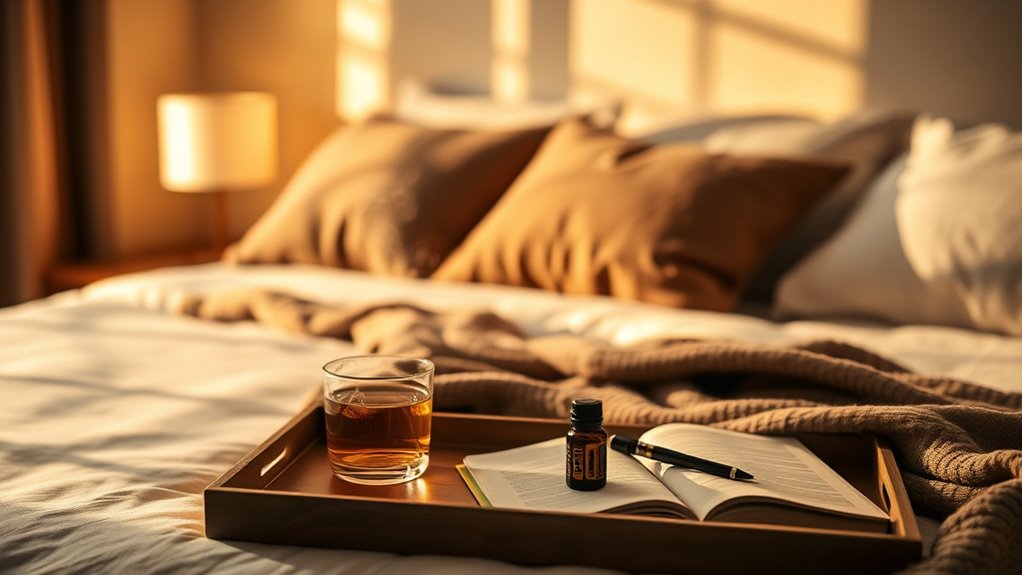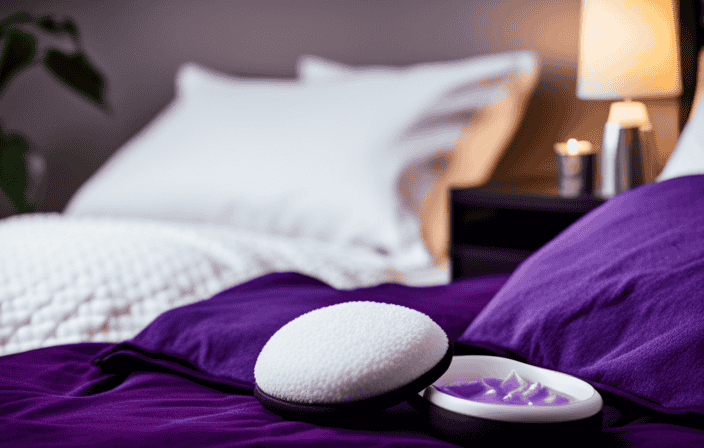The 3‑2‑1 Technique for rapid evening wind‑down helps you relax quickly by focusing your attention on your surroundings. You find three visible objects, two sounds, and one tactile sensation, which grounds you in the present moment. This simple exercise reduces mental clutter, calms racing thoughts, and prepares you for restful sleep. If you want to discover how to easily incorporate this method into your routine, there’s more to explore below.
Key Takeaways
- The 3‑2‑1 Technique is a simple grounding exercise that helps shift focus away from stressful thoughts before sleep.
- It involves identifying three visible objects, two sounds, and one tactile sensation to anchor awareness in the present moment.
- Practicing this technique in the evening promotes relaxation, reduces mental clutter, and eases the transition to restful sleep.
- It can be easily incorporated into a calming bedtime routine and combined with other relaxation methods for enhanced results.
- Using the 3‑2‑1 Technique supports overall sleep hygiene by establishing a consistent wind-down practice that calms the mind.

If you struggle to unwind after a busy day, the 3‑2‑1 technique offers a simple, effective way to relax quickly. When your mind is racing and you find it hard to settle down, establishing a calming pre-sleep routine is essential for good sleep hygiene. Incorporating relaxation methods like the 3‑2‑1 technique can help signal to your body that it’s time to wind down, making it easier to fall asleep and improving your overall quality of rest.
The core idea behind the 3‑2‑1 technique is straightforward. It guides you through a series of grounding exercises that shift your focus away from stressful thoughts and toward the present moment. To start, find a comfortable seated or lying position. Begin by identifying three things you can see around you. Look for details you might normally overlook—perhaps the texture of your bedding or the pattern on the ceiling. This visual acknowledgment helps anchor your awareness in the now, reducing mental clutter. Next, focus on two things you can hear. It could be the hum of your refrigerator, the distant sound of traffic, or your own breathing. Listening carefully helps quiet your mind and fosters a sense of calm.
Then, identify one thing you can feel. It might be the coolness of your sheets, the weight of your blanket, or the sensation of your feet touching the floor. This tactile focus further grounds you and promotes relaxation. The beauty of this technique is that it’s quick and adaptable—perfect for evenings when your thoughts feel overwhelming. Regularly practicing the 3‑2‑1 method can become a crucial part of your sleep hygiene routine, helping you transition smoothly from daytime stress to restful sleep. Additionally, using a home theater projector with high contrast ratio features can create a soothing environment for winding down.
Frequently Asked Questions
Can the 3‑2‑1 Technique Be Customized for Individual Routines?
You can definitely customize the 3‑2‑1 technique based on your needs. Personalization options include adjusting the timing, choosing different calming activities, or integrating the steps into your existing routine. By tailoring it to your preferences, you make it easier to stick with and more effective for winding down. Routine integration is simple—you can incorporate it seamlessly before bed, ensuring it becomes a natural part of your evening.
How Long Does It Typically Take to See Results?
You might find that with consistent use of relaxation techniques like the 3‑2‑1 method, sleep improvement begins to subtly unfold within a few nights. While individual responses vary, many notice better sleep quality and calmer evenings after just one week. Patience is key—sticking with the routine helps your body adapt and rewards you with more restful nights. Keep at it, and positive changes will gradually become part of your nightly routine.
Is the 3‑2‑1 Method Effective for Children?
You might wonder if the 3‑2‑1 method works for children. It can be effective when incorporated into bedtime routines, helping improve sleep hygiene. By establishing consistent cues and signals, children learn to wind down more easily. You’ll notice that with regular practice, they may fall asleep faster and sleep more soundly. Just be patient and consistent, and the method can become a helpful part of their nightly routine.
Are There Any Potential Side Effects or Drawbacks?
You might wonder if there are adverse reactions or dependency risks with the 3-2-1 technique. While generally safe, some people could experience frustration or increased anxiety if they struggle with the routine. There’s little evidence suggesting dependency risks, but it’s good to use the method as part of a balanced sleep routine. Always monitor how it affects you or your child, and consult a professional if concerns arise.
Can This Technique Replace Other Sleep Aids or Medications?
You might think this technique can replace medications, but don’t put all your eggs in one basket. While it’s a great natural sleep aid and a helpful medication alternative, it’s not a one-size-fits-all fix. It may improve your sleep, but for serious issues, combining it with other strategies or consulting a healthcare professional is smart. Relying solely on it might not give you the restful nights you need.
Conclusion
Using the 3‑2‑1 technique can help you unwind quickly and improve your sleep quality. Just a simple routine of three minutes of relaxation, two minutes of breathing, and one minute of reflection can make a big difference. Did you know that nearly 30% of adults struggle with sleep each night? Incorporating this method might be just what you need to relax faster and enjoy more restful nights. Give it a try and see the difference!









